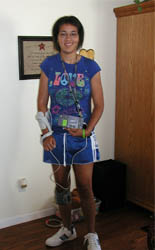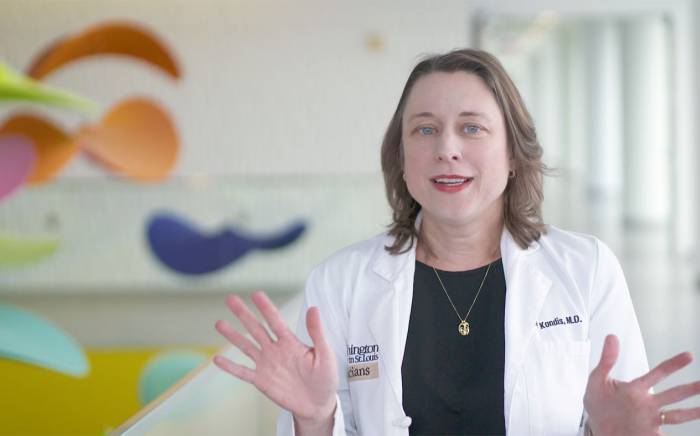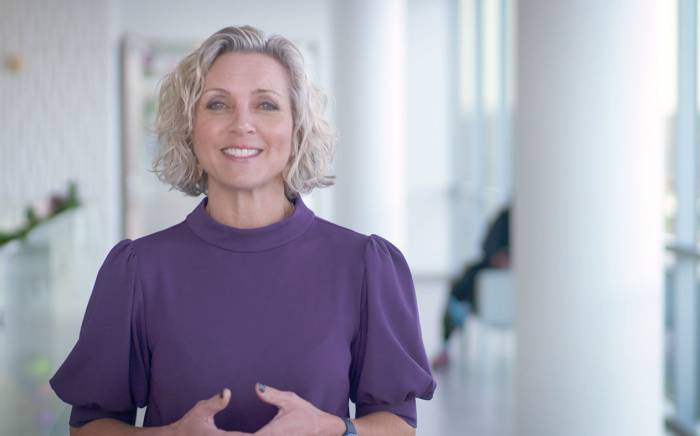 Courtney Phinney will spend the rest of her life making good on a promise – a promise she credits for making the rest of her life possible.
Courtney Phinney will spend the rest of her life making good on a promise – a promise she credits for making the rest of her life possible.
At first glance, the 18-year-old from Fairview Heights, IL, resembles a typical high school senior walking the halls of Belleville East High School. But a closer look reveals the medical apparatus attached to her leg that literally electrifies her muscles into action, and provides a first insight into the frightening path that Courtney has walked.
Her journey began in May 2007, with the diagnosis of a brain tumor called an anaplastic astrocytoma.
“I cried when I found out,” Courtney says. “I didn’t expect it to be cancer. By the time I got the news, I couldn’t even look at the pictures of my brain because I was too blind from the tumor. That made me cry even more.”
“My first thought was, ‘I’m never gonna have grandkids, never gonna see her grow up or graduate or get married,” says Tracey Phinney, Courtney’s mom.
Doctors in the Phinneys’ home town of Indianapolis were reluctant to try removing the tumor – roughly the size of a 12-ounce soda can – and offered a grim long-term outlook.
“They didn’t think she had a fighting chance,” says Tracey. “I wanted a second opinion.”
The search for a second opinion brought Courtney and her mom to St. Louis, and the office of Dr. Jeffrey Leonard, pediatric neurosurgeon at St. Louis Children’s Hospital.
He agreed to operate, but was careful to explain that it would be impossible to remove the entire tumor, that this was a very aggressive form of cancer, and that complete remission was not likely.
Surgery would also carry a strong risk of long-term neurological deficit.
“Courtney showed remarkable courage in this difficult situation,” Dr. Leonard said.
Dr. Leonard was able to successfully remove 40% of the tumor.
But something unexpected happened following the surgery, and following nearly a year of treatment that included radiation and chemotherapy. All signs of the tumor disappeared.
“Her doctors have never seen anything like it,” says Tracey. “She’s amazing - absolutely, positively amazing.”
Courtney’s family and medical team believe she brought on her successful outcome with her unrelenting positive attitude – in spite of ominous statistics on the recurrence of this kind of tumor, and in spite of post-surgical complications including short-term memory loss, peripheral vision damage, and paralysis on the right side of her body.
 Today, Courtney uses a device called a Bioness to help her walk and move around. The Bioness attaches to her right leg and hand, and emits electrical impulses which help move her muscles so she can walk and use that side of her body.
Today, Courtney uses a device called a Bioness to help her walk and move around. The Bioness attaches to her right leg and hand, and emits electrical impulses which help move her muscles so she can walk and use that side of her body.
“She’s definitely more physically limited than she was prior to all of this,” says Tracey.
She also struggles with her school work and, due to her vision challenges, is unable to drive a car.
Roadblocks, perhaps, but not enough to discourage Courtney.
“Courtney has endured everything with a smile on her face,” says Tracey. “It’s been her attitude that’s gotten me through all of this. If she had been a ‘poor me’ child, I would have been a basket case for the last two years.”
Courtney and her mom have made St. Louis their permanent home so they can be close to St. Louis Children’s Hospital for follow-up observation and care. Life away from her hometown is tough for Courtney, but she considers herself lucky.
“It’s hard to make new friends when you’re a senior in high school, and when you’re going through treatment for a brain tumor,” explains Courtney. “But other than that, I’m happy. I have wonderful therapists, wonderful teachers. I have a wonderful mother and a wonderful sister and grandma.”
The Phinneys credit the medical team at St. Louis Children’s Hospital – specifically the neuro-oncology team – for the comprehensive care Courtney received.
“We have a broad multidisciplinary neuro-oncology program willing to push the limits of what we can do and never willing to give up hope,” says Dr. Leonard.
The neuro-oncology program at St. Louis Children’s Hospital sets it apart from other children’s hospital brain tumor programs in the Midwest. On any given visit, a child in the neuro-oncology clinic will see a neurosurgeon, oncologist, radiation oncologist, endocrinologist, social worker, physical therapist and neuropsychologist - members of a specialized team designed to meet each child's individual needs.
But the ultimate force in Courtney’s recovery, according to the Phinneys, was a divine one.
“God was directing us for whatever reason to be here and for whatever reason put us in the hands of Drs. Leonard and Rubin,”says Tracey. (Courtney’s neurosurgeon and oncologist.)
Which brings us back to Courtney’s promise.
The successful outcome of her surgery was something even Dr. Leonard didn’t expect, and which still proves inspirational to him.
“I was pleasantly surprised that her MRI showed no evidence of tumor,” says Dr. Leonard. “Patients like Courtney serve as an inspiration to me. It gives me a new perspective on life and a true illustration of courage.”
But Courtney herself was not surprised.
“After my diagnosis, I dreamed I talked to God,” explains Courtney. “He told me he was going to save me if I promised to share my story so other people know never to give up. I believe if I hadn’t promised God I’d tell people my story, I don’t think I would have survived”
She says she knew, as long as she remained strong and positive, and as long as she shared the news of her amazing recovery with anybody who would listen, that she’d survive to tell her story.
Now, she’s preparing to attend school to become an oncology nurse, so she can offer hope and comfort to others confronting a terrifying diagnosis.
“She’s already given us hope,” says Debra Spoljaric, nurse practitioner at St. Louis Children’s Hospital. “Patients like Courtney continue to give us hope. You see somebody like Courtney who succeeds - it makes it worth it. It gives us hope that we need to keep doing what we’re doing.”
Spoljaric believes Courtney will make an excellent nurse.
“I also want to be a mentor,” says Courtney, “to go to schools and talk to the kids about cancer.”
Whatever she decides to do, those who know her best believe she’ll be a success.
“She will always have a friend in her corner,” says Dr. Leonard.
“She’s defied all odds,” says Tracey. “She’s an absolute miracle.”












